The Cornell Lab Bird Academy › Discussion Groups › Nature Journaling and Field Sketching › The Power of Comparison
-
There’s so much information I want to get in that it’s hard to get it on the page, and between my lack of drawing practice and a certain rush to do the work, the art is literally sketchy. Even working as quickly as I could, this took me about an hour and a half. But I really enjoy the chance to observe. I spend a lot of time grubbing up Bermuda grass and crab grass, so this was a “know thy enemy” exercise. By the time I was done I at least appreciated the structure of both grasses and understood a bit better how they spread. And I’d never noticed the pretty purple on some of the Bermuda grass stems before. Now I’m curious why some are purple and some aren’t.

-
I have been waiting for my weekend to do this. Finally, it is Saturday but it was 12 degrees this morning! So I went to pick up some freshly fallen leaves in my yard. I picked up 2 very different leaves fallen from one of my purple Smoke bushes. They are quite distinct, which really intrigues me since they come from the same tree. The mise-en-page is quite improvised, a bit messy, I had a lot of descriptions to record and not enough room on my small pad. I’ve got to think of that next time. Anyway, here they are. Nice seeing everyone’s work. Thanks for sharing y’all. Isabelle

-
 This was my first comparison study and I enjoyed the experience. No doubt, even though my fingers felt warm upon starting, had they not cooled off 30 minutes later then I would still be outdoors sketching and observing.
This comparison study of grasses reminded me that comparing and contrasting can be a highly effective way to learn about something. The questions that arose are mainly based around the labeling of parts - flowers, stalks, stems, leaves, grass - I do not know what to properly name each part of the grasses. Had my fingers not gotten cold, I would have mustered the umph to draw a close up of each grass's flowers. They have similarities but are not the same.
I like sketching what I see, labeling parts and then using the drawing and my observations to prompt my words. This lets me practice the skill - drawing - that I'm trying to learn.
I incorporated numerical data, which likely would not have happened if this exercise had been done without seeing Liz's modeling it in her example. Certainly, the use of numerical data adds credence to a scientific observation, while also enhancing the descriptiveness of what is being viewed.
FYI I am thoroughly enjoying myself in this course! I set aside time each weekend to do one or two parts of a chapter, not wanting to rush on any given day and hoping to make this class last well into December. Thank you Liz and Bird Academy!
This was my first comparison study and I enjoyed the experience. No doubt, even though my fingers felt warm upon starting, had they not cooled off 30 minutes later then I would still be outdoors sketching and observing.
This comparison study of grasses reminded me that comparing and contrasting can be a highly effective way to learn about something. The questions that arose are mainly based around the labeling of parts - flowers, stalks, stems, leaves, grass - I do not know what to properly name each part of the grasses. Had my fingers not gotten cold, I would have mustered the umph to draw a close up of each grass's flowers. They have similarities but are not the same.
I like sketching what I see, labeling parts and then using the drawing and my observations to prompt my words. This lets me practice the skill - drawing - that I'm trying to learn.
I incorporated numerical data, which likely would not have happened if this exercise had been done without seeing Liz's modeling it in her example. Certainly, the use of numerical data adds credence to a scientific observation, while also enhancing the descriptiveness of what is being viewed.
FYI I am thoroughly enjoying myself in this course! I set aside time each weekend to do one or two parts of a chapter, not wanting to rush on any given day and hoping to make this class last well into December. Thank you Liz and Bird Academy! -
I guess I like to work big! I compared 3 seed heads / pods as it's winter and NO flowers, even the leaves are all gone. This was very fun and I did get to wonder about prickles, opposite vs. alternate leaves (I could tell by the attachment points that remained) and stem striations. I liked having all the information, drawing, writing, as well as a little bit about size. This lesson was very useful for me to think about all the things that can vary from subject to subject.



-
These are great. I was working on a milkweed pod, too, and I noticed that the seeds, which I always "knew" were a flat ellipse/teardrop shape with a seed in the middle and a skrim of "wing" on the perimeter, are actually curved like a human spine when observed from the side. Perhaps this allows them to catch a lighter breeze or travel further?
-
You've inspiring! You model close observation of a variety of issues on your seed pods--and pose questions.
-
Very nice composition of your page and beautiful drawings.
-
-

-
I have really enjoyed the comparison drawings. It has created a deeper layer of observation and patience. I found this beautiful Maple leaf on a hike and brought it home to draw; then, a few days later found the Oak leaf. Both leaves were inspiring in different ways. Thank you for this exercise!
-


-
These leaves are stunning. The colors are so beautiful. Well done!
-
@Janice I agree! Valerie, are you using colored pencils or watercolors? Your colors are so vibrant!
-
-
 I really enjoyed drawing these 2 flowers. I used a picture that I took back in September. There was enough information in the picture that I took to record the flowers and the leaves for each plant. This was really fun. I will be doing more of these types of studies. Thank you!
I really enjoyed drawing these 2 flowers. I used a picture that I took back in September. There was enough information in the picture that I took to record the flowers and the leaves for each plant. This was really fun. I will be doing more of these types of studies. Thank you! -
I enjoyed this comparison study as it encouraged me to focus on fine details of each leaf. Autumn is the best season to study leaf structures and color changes. This study allowed me to ask very curiously questions, such as why the color changes of each leaf are different and how the cooler temperatures affect this change. After completing each drawing, I found myself returning to add more detail.

-
I am enjoying comparison studies, I have been focusing on patterns and got out my hand lens recently for closer looks. I found that acorns have more texture to them than is obvious to the naked eye and that pine cones are really hard to draw.

-
I think making the comparisons helped me pay more attention to the details. Writing and recording numerical data provide information I am unable to successfully show in my drawings. As my drawing skills improve, I will probably incorporate less writing and data.

-
 1) I compared two plants on my deck. I am a beginner at sketching and it took me a lot of time. I enjoyed it so much but this did make me wonder how I can adapt my work for going out in the field--my goal for my nature journal. I know that practice will help me work more efficiently, but are there other things I can do to capture important points about the subjects in a shorter time period? Birds are not going to sit still for me.
I continue to be surprised by just how much more I observe when I draw. Drawing also gives me more time to think about questions I have. I have a biology background, so I think my observational skills are quite good. However, this study showed me just how much more I can grow in this regard.
2)This question of balance is key for me. When I finished drawing, I first thought I was done until I realized I had done no writing! Quantitative data is important, but asking questions led me to go back and do even more observations. I have an additional page or writing I didn't upload. In the earlier video on journal styles, one person had lots of boxes on her pages. I think this might be useful for me to use this more to force me to have a box for quantitative data, one for qualitative observations, one for questions , etc.
1) I compared two plants on my deck. I am a beginner at sketching and it took me a lot of time. I enjoyed it so much but this did make me wonder how I can adapt my work for going out in the field--my goal for my nature journal. I know that practice will help me work more efficiently, but are there other things I can do to capture important points about the subjects in a shorter time period? Birds are not going to sit still for me.
I continue to be surprised by just how much more I observe when I draw. Drawing also gives me more time to think about questions I have. I have a biology background, so I think my observational skills are quite good. However, this study showed me just how much more I can grow in this regard.
2)This question of balance is key for me. When I finished drawing, I first thought I was done until I realized I had done no writing! Quantitative data is important, but asking questions led me to go back and do even more observations. I have an additional page or writing I didn't upload. In the earlier video on journal styles, one person had lots of boxes on her pages. I think this might be useful for me to use this more to force me to have a box for quantitative data, one for qualitative observations, one for questions , etc. -
These are beautifully rendered. The shading using stippling works really well and you captured the dimensionality and depth in the individual plants. Congrats!
-
@Susan Thanks so much for the kind words!
-
-
Another rainy day comparison. I used a hand lens to look closely at the two plants.

-
 Today was way to smokey to go outside but I had these pine cones as part of an indoor arrangement. Watching our instructor draw her comparisons really helped me. I have very little experience and learned a lot from watching her.
Today was way to smokey to go outside but I had these pine cones as part of an indoor arrangement. Watching our instructor draw her comparisons really helped me. I have very little experience and learned a lot from watching her. -
I have been putting this off because of rain and then we had a hard freeze last night so there went the flowers. So I chose the berries. This assignment is great because it is really helping me to be more observant. I'm having fun with these challanges.

-

-
 1.) I really enjoyed this study. These feathers have been on my mantle for six months, but I truly saw them for the first time tonight. I learned that, although they have the same basic pattern elements, there are big differences in coloration, speckling, and contrast.
2.) I would like to try to add more numerical data because I have never thought to do it before. It would make it more scientific. I have only ever noted the presence of birds I hear while journaling so that I can imagine the atmosphere after the fact. It would be interesting to count plants, flowers, insects etc as well.
1.) I really enjoyed this study. These feathers have been on my mantle for six months, but I truly saw them for the first time tonight. I learned that, although they have the same basic pattern elements, there are big differences in coloration, speckling, and contrast.
2.) I would like to try to add more numerical data because I have never thought to do it before. It would make it more scientific. I have only ever noted the presence of birds I hear while journaling so that I can imagine the atmosphere after the fact. It would be interesting to count plants, flowers, insects etc as well. -
I enjoyed this activity. I selected two specimens of Holly from my garden. It was interesting to examine the many differences between the plants. The Winterberry was new to my garden so a fairly immature plant while the English Holly is very large and over 25 years old. I thought the difference in the leaves were especially interesting. I took some additional time to read about both species. I learned a bit about how to distinguish English Holly from native American Holly.

-

-
Comparison study of two different maple leaves, with shadow and palette practice. The sugar maple is not quite as dark as I expected, but the watercolors are very new for me. Not much painting experience or even detailed drawing prior to this course.

-
I love that you're experimenting with color. It not only adds more data about the leaves you're comparing, it also really brings the images to life, as if you've invited the readers along on your outing. I have a watercolor set but I still haven't dipped a brush into it. Seeing your work is really making me want to try adding color to my descriptions. Thanks!
-
-
Autumn garden makes for some good comparison of plants at the end of season.

-
Colorful leave are falling everywhere and I wondered what determines their colors. I drew an Northern Red Oak leaf which is reddish and a yellow Norway Maple for comparison. Checking on Wikipedia I found there are 2 pigments present after their the chlorophyll has left the leaves because of dropping temperatures and less sunlight. Carotenoids which are already present in the leaf come through as yellow, orange and brown. Anthrocyanins present as reds and purples. Thank you Wikipedia.

-
I started with the drawings and then added descriptions of the subjects. I’d like to also use the journal to remember a walk or a special time with family. The comparison study is informative and enjoyable. My second comparison of two very similar flowers, the vinca and impatiens was rewarding.
-


-
Was able to finally go outside and devote some time to this. I was surprised at the differences in the 2 leaves. I fear my drawings do not reflect that but perhaps in time...I am attempting photography and this course
 will help me see the small details I have overlooked so far. I think I need to work on ordering the writing so it makes sense when you go back to review. As others have said, writing with a pencil is taking me back...old school!
will help me see the small details I have overlooked so far. I think I need to work on ordering the writing so it makes sense when you go back to review. As others have said, writing with a pencil is taking me back...old school! -
I am really taken by your close observations on these two seemingly simple objects. Your sketches really give me the "feel" of these two leaves and how different they are. Your observations are so good and so diverse--exposure to sunlight, leaf and bark texture, leaf margins, vein pattern. This made me realize that I should have narrowed my scope and made better observations on a smaller scale.
-
Read More:
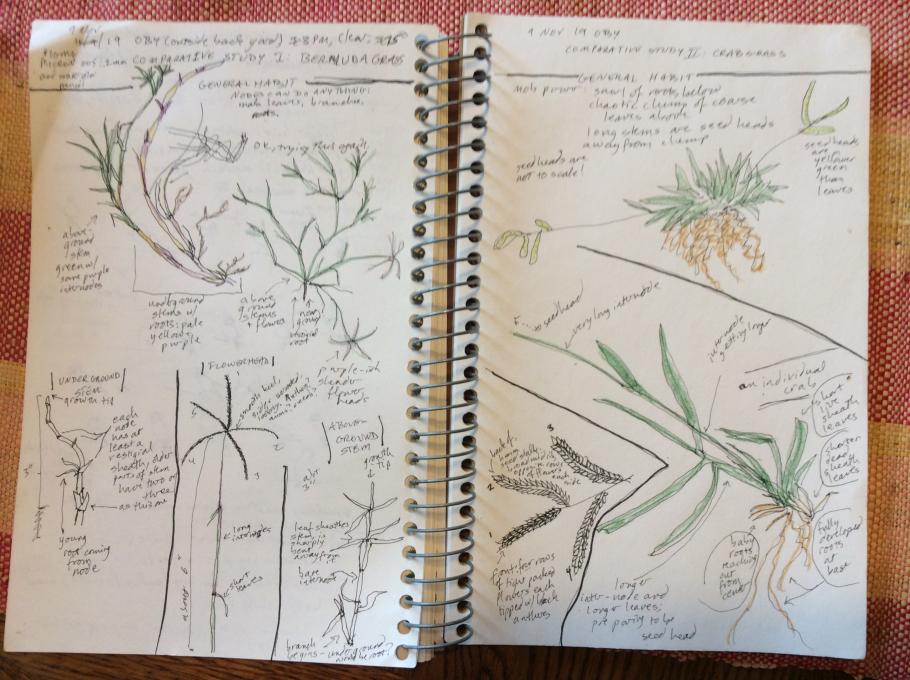
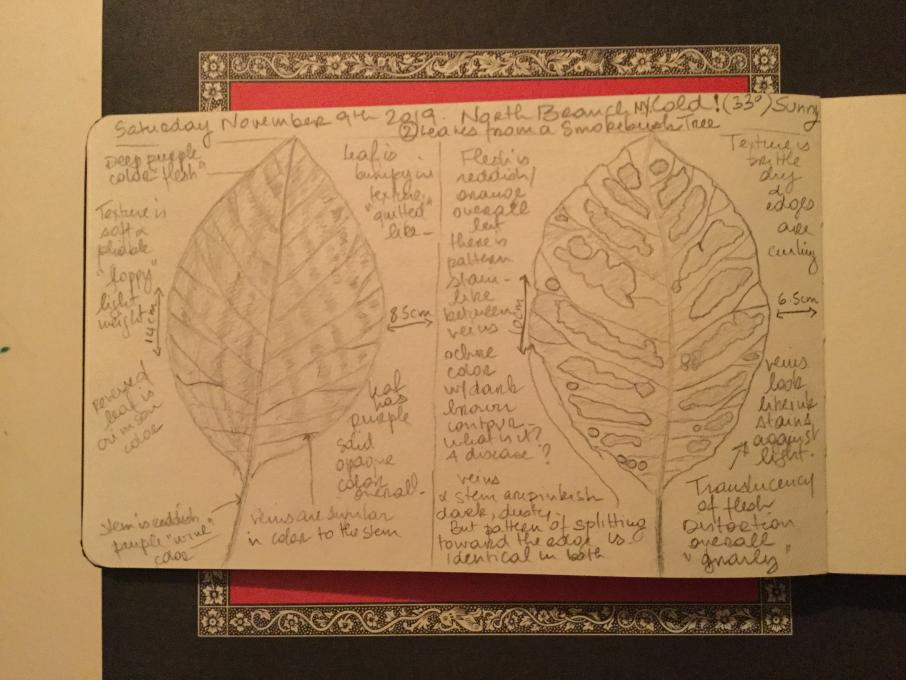
 This was my first comparison study and I enjoyed the experience. No doubt, even though my fingers felt warm upon starting, had they not cooled off 30 minutes later then I would still be outdoors sketching and observing.
This comparison study of grasses reminded me that comparing and contrasting can be a highly effective way to learn about something. The questions that arose are mainly based around the labeling of parts - flowers, stalks, stems, leaves, grass - I do not know what to properly name each part of the grasses. Had my fingers not gotten cold, I would have mustered the umph to draw a close up of each grass's flowers. They have similarities but are not the same.
I like sketching what I see, labeling parts and then using the drawing and my observations to prompt my words. This lets me practice the skill - drawing - that I'm trying to learn.
I incorporated numerical data, which likely would not have happened if this exercise had been done without seeing Liz's modeling it in her example. Certainly, the use of numerical data adds credence to a scientific observation, while also enhancing the descriptiveness of what is being viewed.
FYI I am thoroughly enjoying myself in this course! I set aside time each weekend to do one or two parts of a chapter, not wanting to rush on any given day and hoping to make this class last well into December. Thank you Liz and Bird Academy!
This was my first comparison study and I enjoyed the experience. No doubt, even though my fingers felt warm upon starting, had they not cooled off 30 minutes later then I would still be outdoors sketching and observing.
This comparison study of grasses reminded me that comparing and contrasting can be a highly effective way to learn about something. The questions that arose are mainly based around the labeling of parts - flowers, stalks, stems, leaves, grass - I do not know what to properly name each part of the grasses. Had my fingers not gotten cold, I would have mustered the umph to draw a close up of each grass's flowers. They have similarities but are not the same.
I like sketching what I see, labeling parts and then using the drawing and my observations to prompt my words. This lets me practice the skill - drawing - that I'm trying to learn.
I incorporated numerical data, which likely would not have happened if this exercise had been done without seeing Liz's modeling it in her example. Certainly, the use of numerical data adds credence to a scientific observation, while also enhancing the descriptiveness of what is being viewed.
FYI I am thoroughly enjoying myself in this course! I set aside time each weekend to do one or two parts of a chapter, not wanting to rush on any given day and hoping to make this class last well into December. Thank you Liz and Bird Academy! 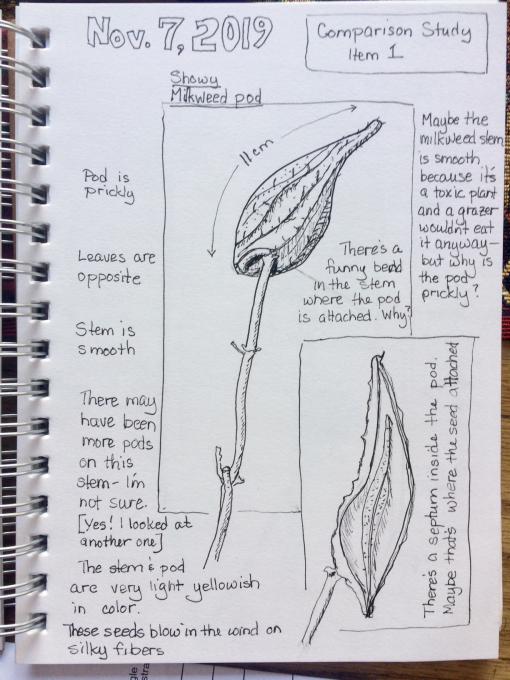
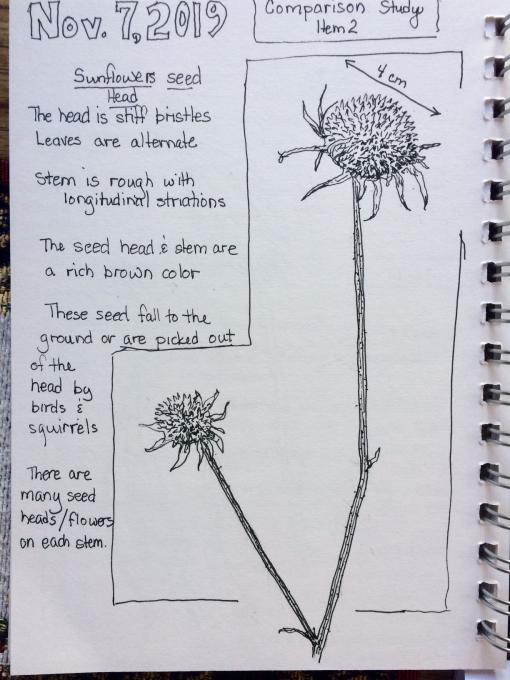
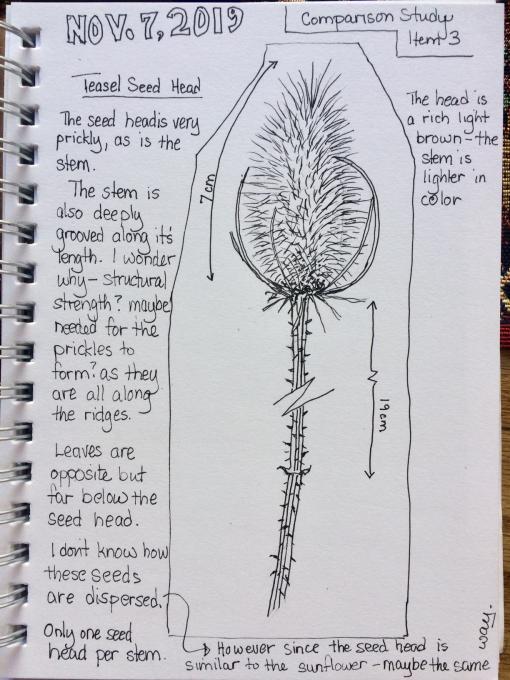
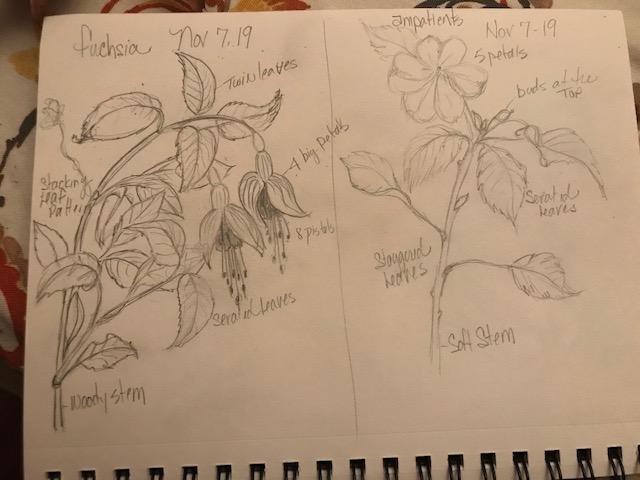
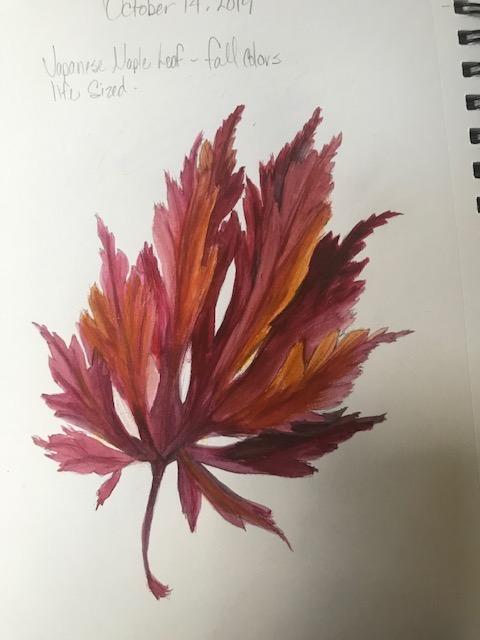

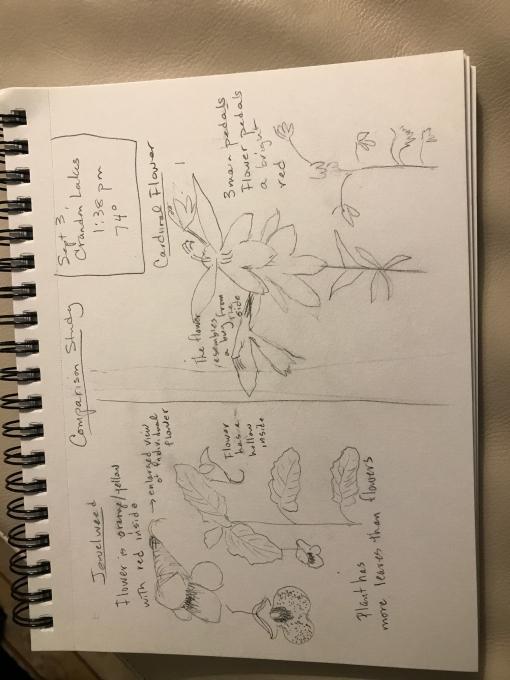 I really enjoyed drawing these 2 flowers. I used a picture that I took back in September. There was enough information in the picture that I took to record the flowers and the leaves for each plant. This was really fun. I will be doing more of these types of studies. Thank you!
I really enjoyed drawing these 2 flowers. I used a picture that I took back in September. There was enough information in the picture that I took to record the flowers and the leaves for each plant. This was really fun. I will be doing more of these types of studies. Thank you! 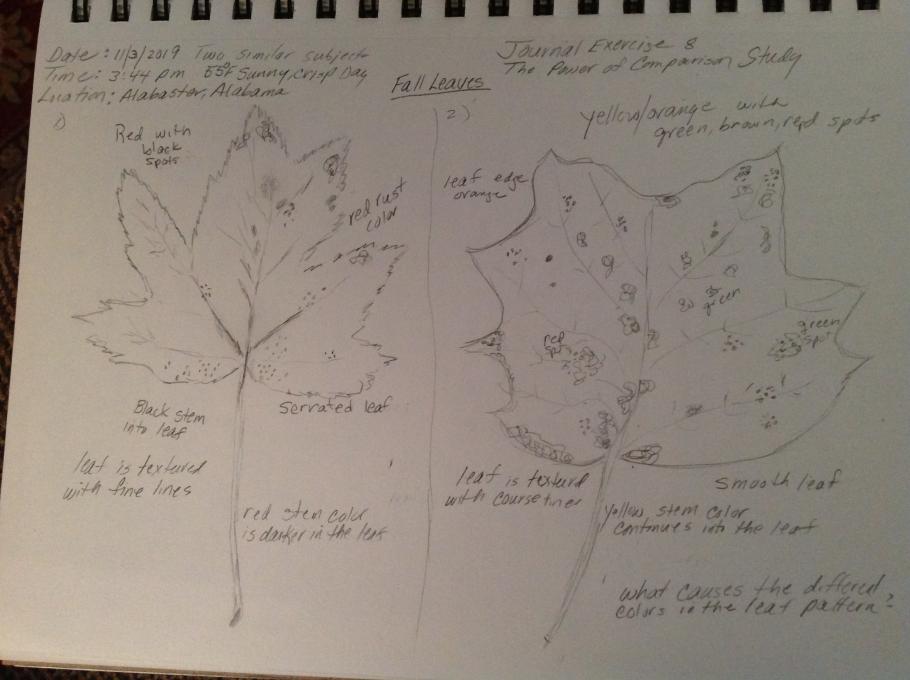
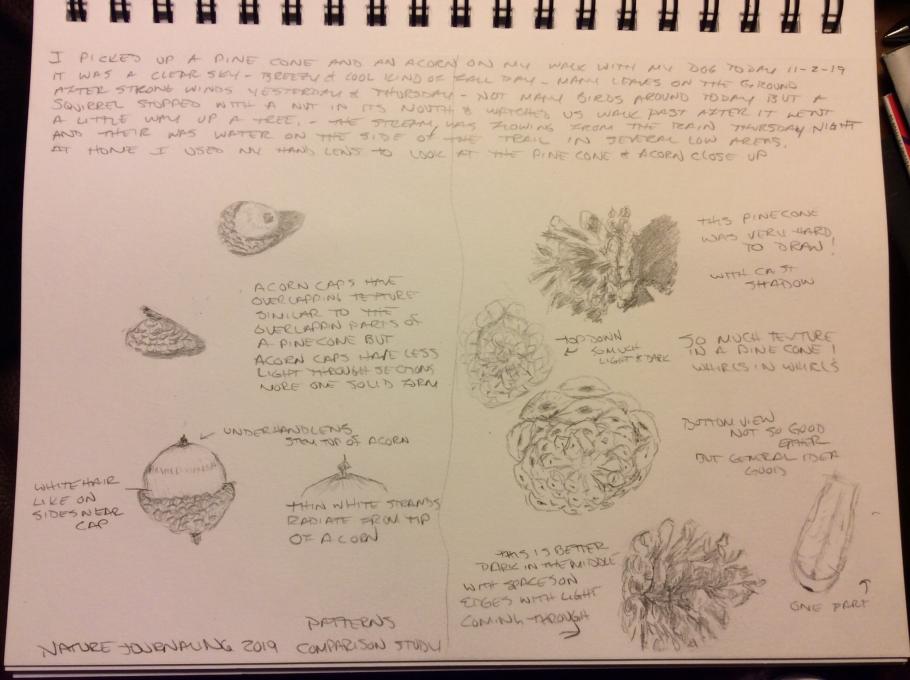
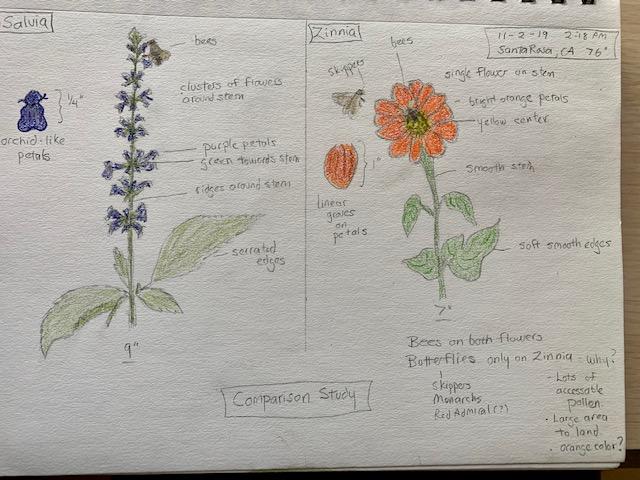
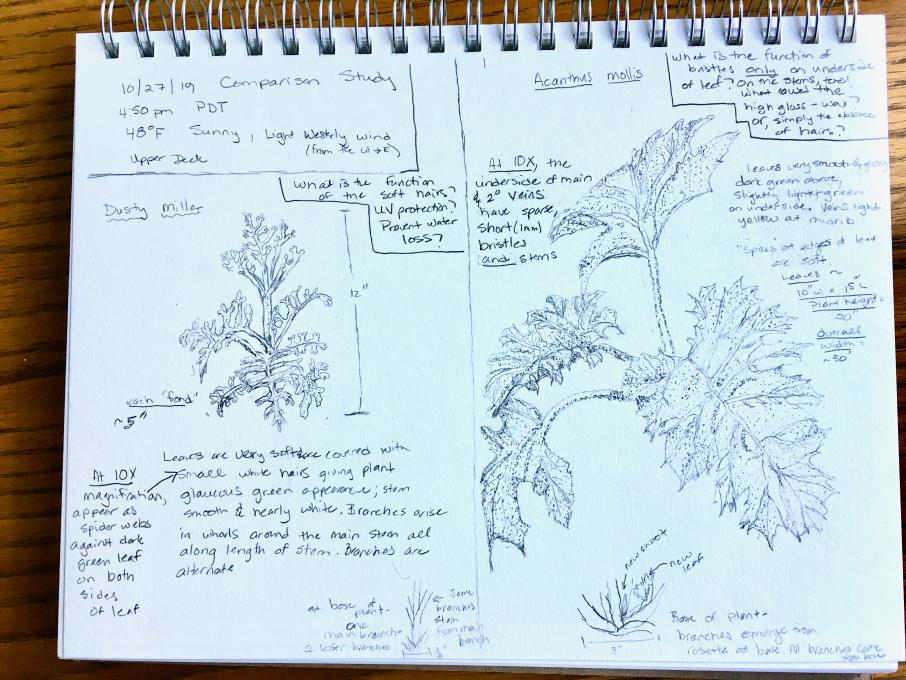 1) I compared two plants on my deck. I am a beginner at sketching and it took me a lot of time. I enjoyed it so much but this did make me wonder how I can adapt my work for going out in the field--my goal for my nature journal. I know that practice will help me work more efficiently, but are there other things I can do to capture important points about the subjects in a shorter time period? Birds are not going to sit still for me.
I continue to be surprised by just how much more I observe when I draw. Drawing also gives me more time to think about questions I have. I have a biology background, so I think my observational skills are quite good. However, this study showed me just how much more I can grow in this regard.
2)This question of balance is key for me. When I finished drawing, I first thought I was done until I realized I had done no writing! Quantitative data is important, but asking questions led me to go back and do even more observations. I have an additional page or writing I didn't upload. In the earlier video on journal styles, one person had lots of boxes on her pages. I think this might be useful for me to use this more to force me to have a box for quantitative data, one for qualitative observations, one for questions , etc.
1) I compared two plants on my deck. I am a beginner at sketching and it took me a lot of time. I enjoyed it so much but this did make me wonder how I can adapt my work for going out in the field--my goal for my nature journal. I know that practice will help me work more efficiently, but are there other things I can do to capture important points about the subjects in a shorter time period? Birds are not going to sit still for me.
I continue to be surprised by just how much more I observe when I draw. Drawing also gives me more time to think about questions I have. I have a biology background, so I think my observational skills are quite good. However, this study showed me just how much more I can grow in this regard.
2)This question of balance is key for me. When I finished drawing, I first thought I was done until I realized I had done no writing! Quantitative data is important, but asking questions led me to go back and do even more observations. I have an additional page or writing I didn't upload. In the earlier video on journal styles, one person had lots of boxes on her pages. I think this might be useful for me to use this more to force me to have a box for quantitative data, one for qualitative observations, one for questions , etc. 
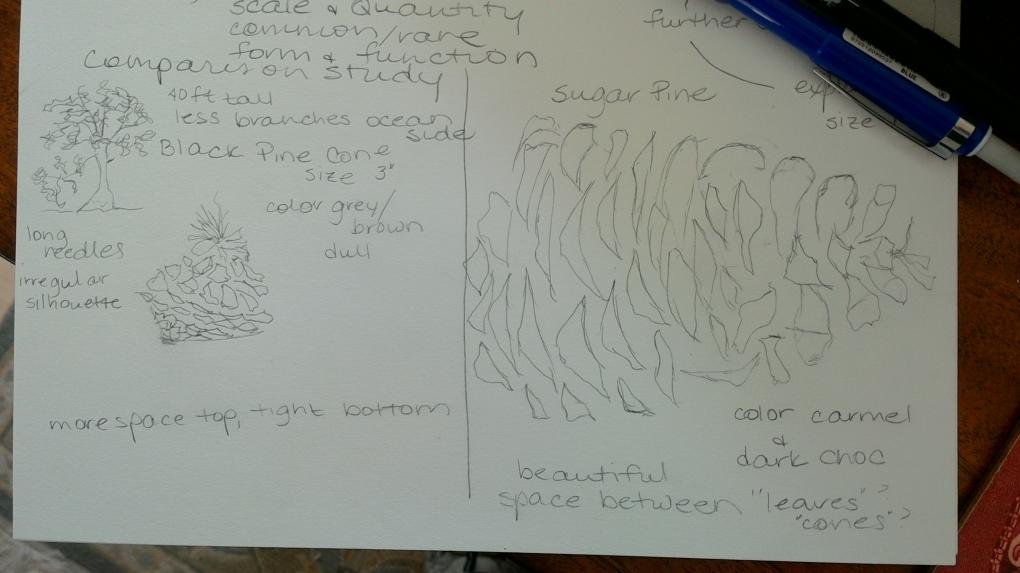 Today was way to smokey to go outside but I had these pine cones as part of an indoor arrangement. Watching our instructor draw her comparisons really helped me. I have very little experience and learned a lot from watching her.
Today was way to smokey to go outside but I had these pine cones as part of an indoor arrangement. Watching our instructor draw her comparisons really helped me. I have very little experience and learned a lot from watching her. 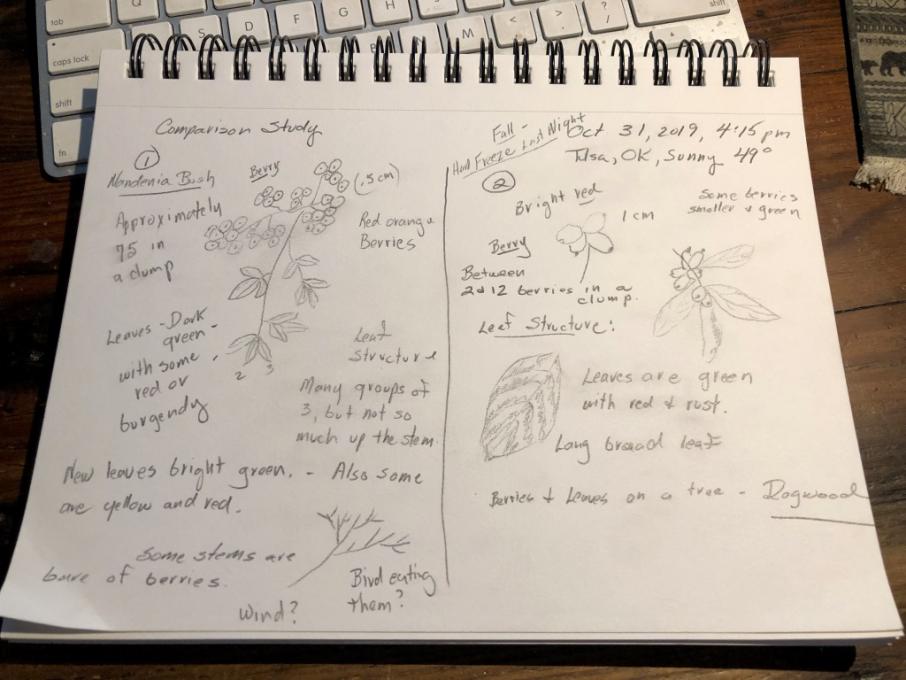
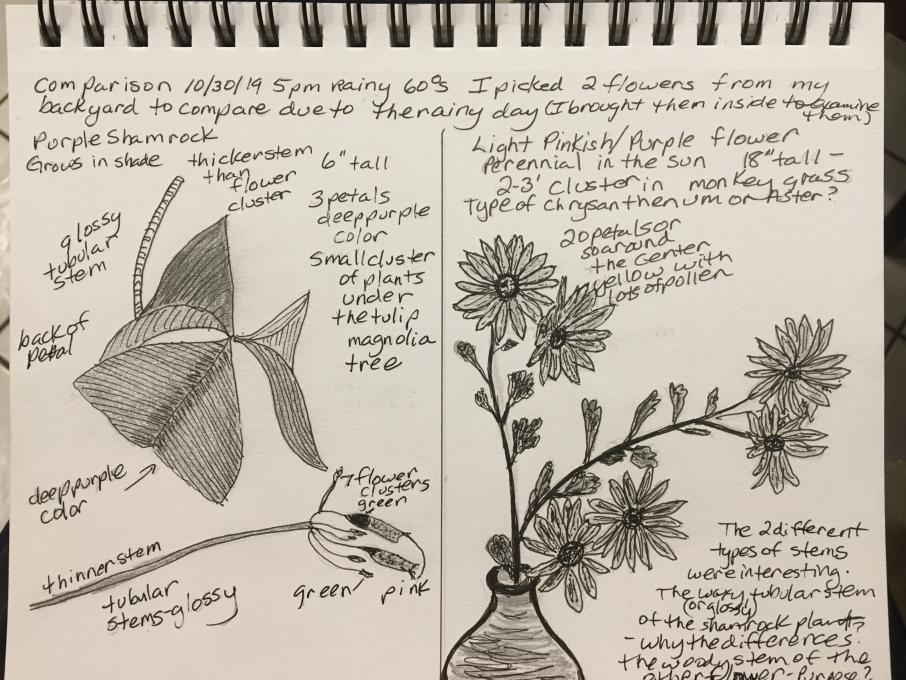
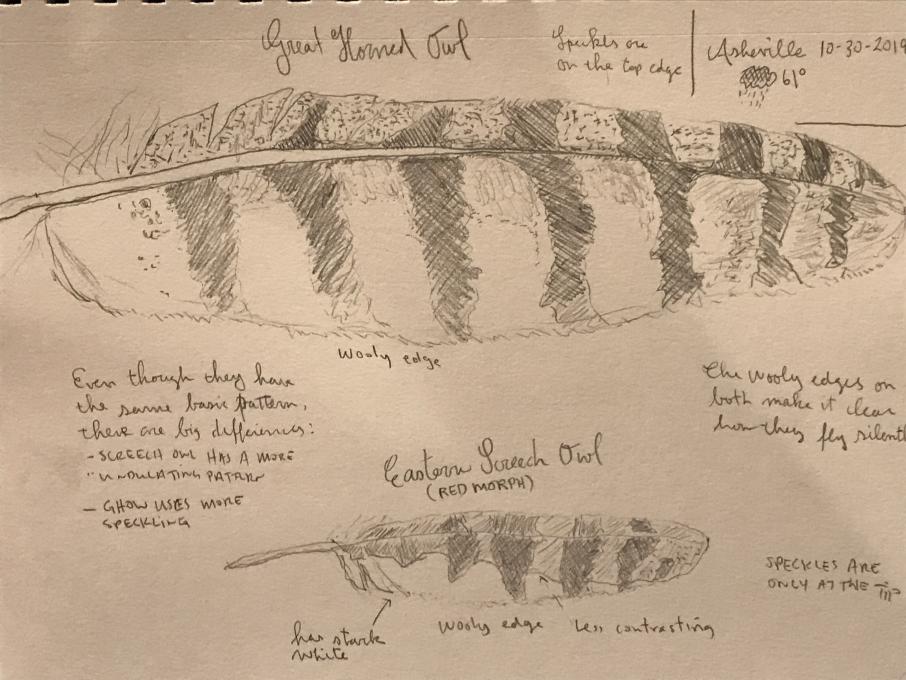 1.) I really enjoyed this study. These feathers have been on my mantle for six months, but I truly saw them for the first time tonight. I learned that, although they have the same basic pattern elements, there are big differences in coloration, speckling, and contrast.
2.) I would like to try to add more numerical data because I have never thought to do it before. It would make it more scientific. I have only ever noted the presence of birds I hear while journaling so that I can imagine the atmosphere after the fact. It would be interesting to count plants, flowers, insects etc as well.
1.) I really enjoyed this study. These feathers have been on my mantle for six months, but I truly saw them for the first time tonight. I learned that, although they have the same basic pattern elements, there are big differences in coloration, speckling, and contrast.
2.) I would like to try to add more numerical data because I have never thought to do it before. It would make it more scientific. I have only ever noted the presence of birds I hear while journaling so that I can imagine the atmosphere after the fact. It would be interesting to count plants, flowers, insects etc as well. 
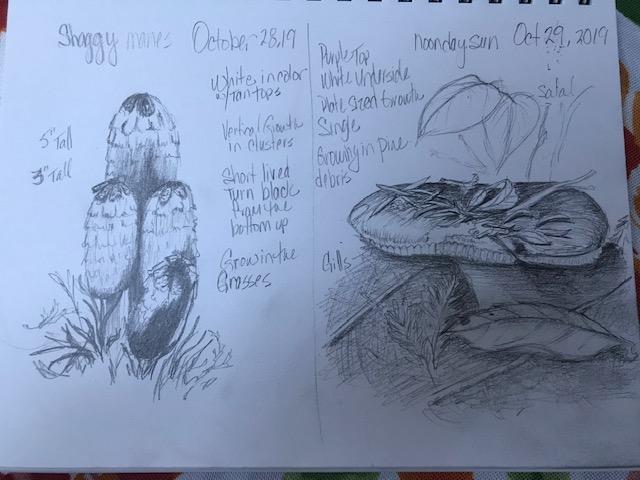
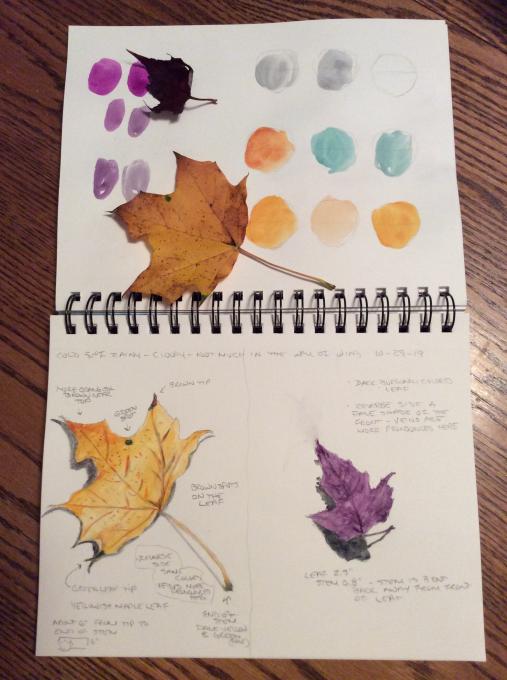
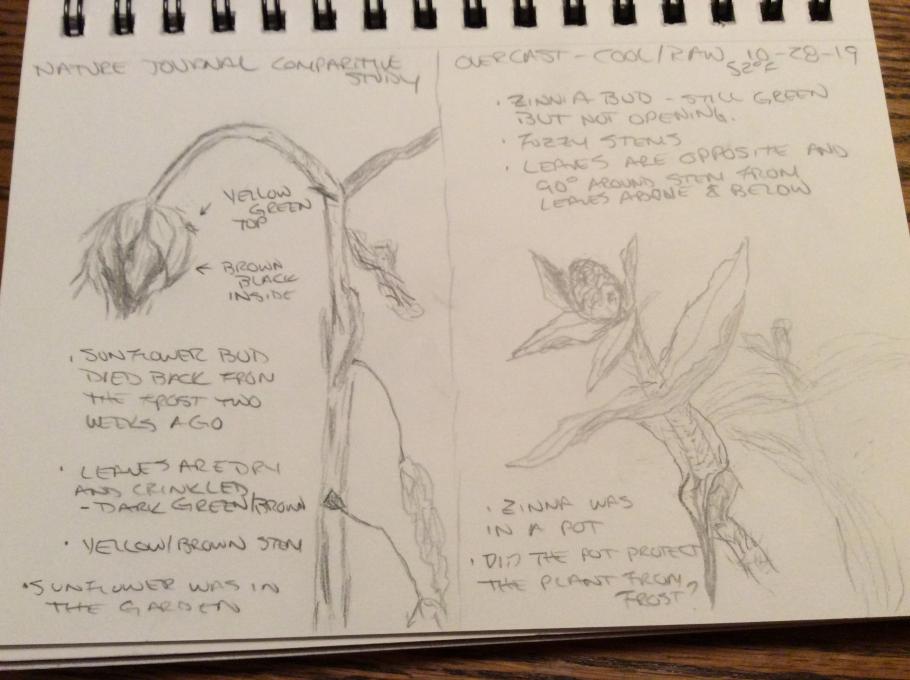
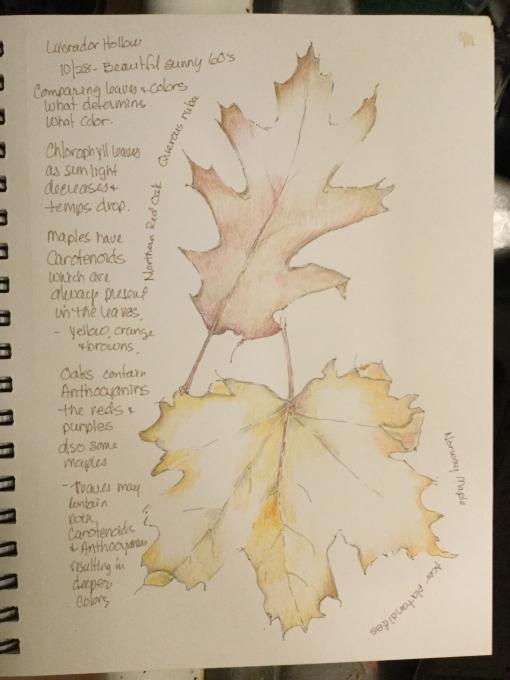
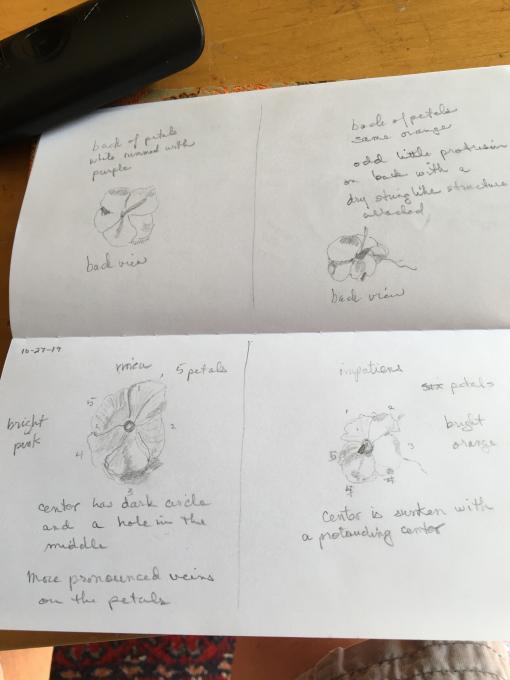

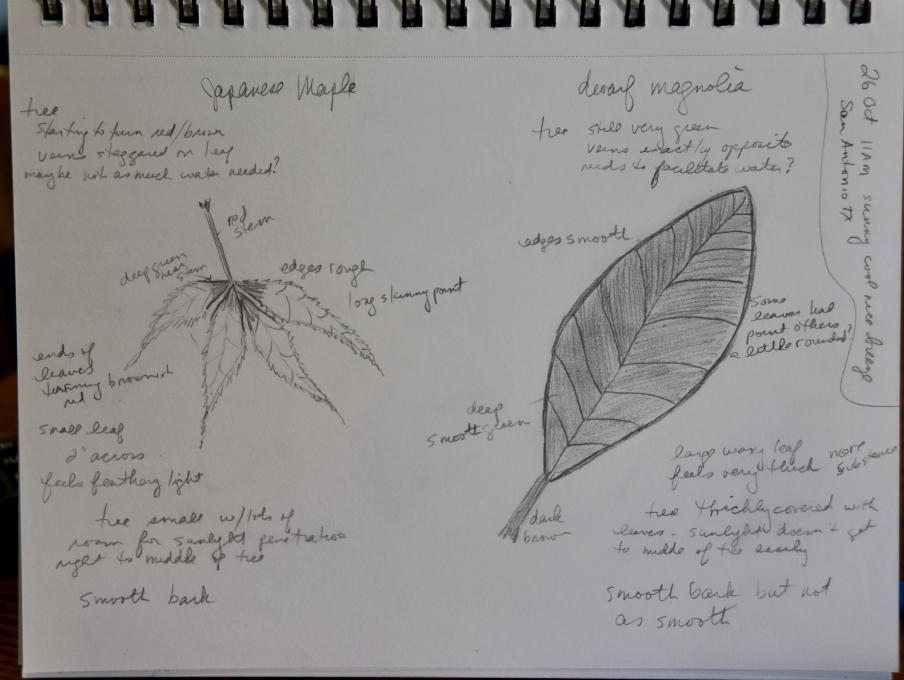 will help me see the small details I have overlooked so far. I think I need to work on ordering the writing so it makes sense when you go back to review. As others have said, writing with a pencil is taking me back...old school!
will help me see the small details I have overlooked so far. I think I need to work on ordering the writing so it makes sense when you go back to review. As others have said, writing with a pencil is taking me back...old school!